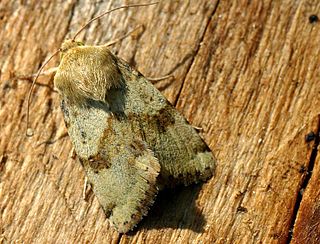
Heliothis viriplaca, the marbled clover, is a moth of the family Noctuoidea. It is found in Europe and across the Palearctic to Central Asia then to Japan, Korea and Sakhalin. In the south, it penetrates to Kashmir and Myanmar. As a migratory moth, it also reaches areas in northern Fennoscandia in some years. North of the Alps, both indigenous and immigrant individuals occur in certain areas. The heat-loving species occurs mainly on dry grasslands, fallow land, heathlands and sunny slopes and slopes and the edges of sand and gravel pits.
Antaeotricha pseudochyta is a species of moth of the family Depressariidae. It is found in Guyana and Grenada.
Antaeotricha crypsiphaea is a moth of the family Depressariidae. It is found in Brazil (Para).
Antaeotricha fulta is a moth of the family Depressariidae. It is found in Colombia.
Antaeotricha trichonota is a species of moth of the family Depressariidae. It is found in Brazil and Paraguay.
Antaeotricha marmorea is a moth of the family Depressariidae. It is found in Brazil and Bolivia.
Antaeotricha reprehensa is a species of moth of the family Depressariidae. It is found in Brazil and Argentina.
Antaeotricha habilis is a moth of the family Depressariidae. It is found in Guyana.
Antaeotricha diplosaris is a moth of the family Depressariidae. It is found in Guyana.
Antaeotricha tribomias is a species of moth of the family Depressariidae. It is found in Guyana.
Antaeotricha tremulella is a species of moth of the family Depressariidae. It is found in the Guianas and Brazil.
Antaeotricha anaclintris is a species of moth of the family Depressariidae. It is found in French Guiana.
Antaeotricha discolor is a moth in the family Depressariidae. It was described by Lord Walsingham in 1912. It is found in Mexico (Guerrero) and Guatemala.
Antaeotricha hemiscia is a moth in the family Depressariidae. It was described by Lord Walsingham in 1912. It is found in Guatemala.
Antaeotricha machetes is a moth in the family Depressariidae. It was described by Lord Walsingham in 1912. It is found in Mexico (Guerrero).
Antaeotricha ostodes is a moth in the family Depressariidae. It was described by Lord Walsingham in 1913. It is found in Guatemala.
Antaeotricha eucoma is a moth in the family Depressariidae. It was described by Edward Meyrick in 1925. It is found in Brazil.
Antaeotricha coriodes is a moth in the family Depressariidae. It was described by Edward Meyrick in 1915. It is found in Guyana.
Antaeotricha epignampta is a moth in the family Depressariidae. It was described by Edward Meyrick in 1915. It is found in Peru.
Antaeotricha euthrinca is a species of moth in the family Depressariidae. It was described by Edward Meyrick in 1915. It is found in Colombia.
